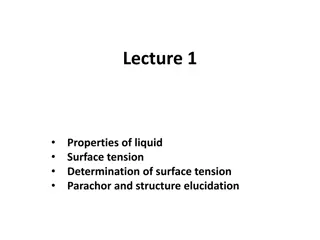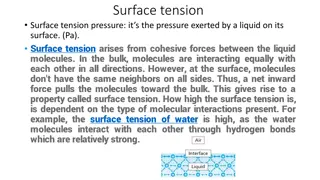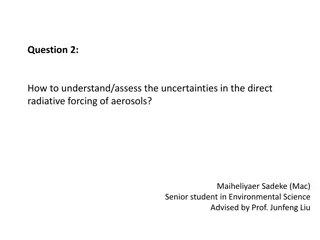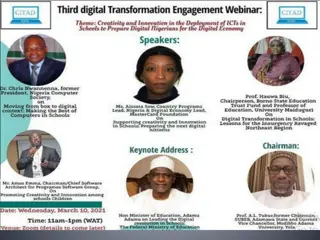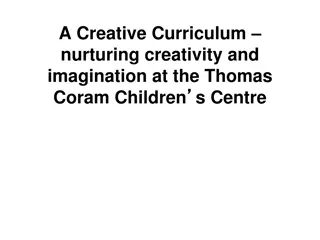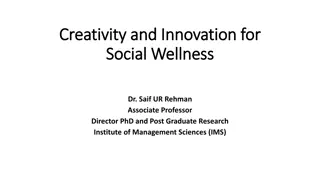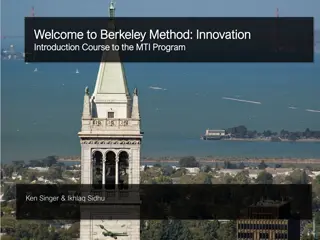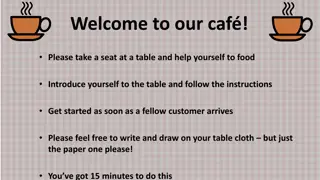Managing Tension Between Creativity and Efficiency: A Framework for Uncertainty in Innovation
Explore the tension between creativity and efficiency in innovation through Pearsons' Uncertainty Map (1991), which categorizes uncertainty about ends and means. The map helps analyze uncertainty in various innovation processes, from exploratory research to improving existing products, offering insights into managing innovation effectively.
Download Presentation

Please find below an Image/Link to download the presentation.
The content on the website is provided AS IS for your information and personal use only. It may not be sold, licensed, or shared on other websites without obtaining consent from the author.If you encounter any issues during the download, it is possible that the publisher has removed the file from their server.
You are allowed to download the files provided on this website for personal or commercial use, subject to the condition that they are used lawfully. All files are the property of their respective owners.
The content on the website is provided AS IS for your information and personal use only. It may not be sold, licensed, or shared on other websites without obtaining consent from the author.
E N D
Presentation Transcript
Figure 3.1 Managing the tension between the need for creativity and efficiency
Pearsons uncertainty map (1991) provides a framework for analysing and understanding uncertainty and the innovation process. The framework is divided into two separate dimensions Uncertainty about ends Uncertainty about means
Figure 3.2Pearsons uncertainty map Source: A.W. Pearson (1991) Managing innovation: an uncertainty reduction process , in Managing Innovation, J. Henry and D. Walker (eds), Sage/OU.
High degree of uncertainty Ultimate target not defined, and how to achieve the target is also not clear. Labeled as exploratory research or blue sky research. Conducted at universities or large organizations Ex: A high-profile contemporary example of blue-skies research is the Large Hadron Collider, or LHC, at CERN in Switzerland. It s the largest scientific experiment ever built, an incredible engineering feat which accelerates protons to 99.999999% the speed of light very nearly the fastest it s possible to go to probe the inner structure of matter and understand the fundamental workings of the Universe. Indeed, 2012 saw the discovery of a particle called the Higgs boson which explains why other particles like electrons have mass. This confirmed a theoretical prediction made in the 1960s, and won Peter Higgs and Fran ois Englert the 2013 Nobel prize.
The end or target is clear A commercial opportunity identified but as yet the means of fulfilling this has yet to be established.
In this area there is uncertainty regarding ends. It is associated with attempting to discover how the technology can be most effectively used.
This area covers innovative activities where there is most certainty. Activities may be dominated by improving existing products. Speed of development is the key to success.
If firms wish to improve innovation performance they first need to put in place and then develop factors that stimulate innovation Figure 3.5 Innovation stimulus, capacity and performance Source: D.I. Prajogo and P.K. Ahmed (2006).
Figure 3.6 Critical factors for innovation success Source: van der Panne et al. (2003).
Table 3.1 Innovation management measurement areas Source: Adams et al. (2006).
Growth orientation Actively plan for the long term. Innovation a means to achieving growth Growth orientation Organisational Heritage and culture is indisputably considered crucial to the firm s technological capabilities as it fosters and encourages widespread recognition of the need to innovate Organisational heritage and innovation experience heritage and innovation experience Vigilance and external links Vigilance requires continuous external scanning. A open communication system Extensive external linkages with the market, competitors , customers , suppliers and others will contribute to the flow of information into the firm Vigilance and external links
Commitment to technology and R&D intensity Exhibit patience in permitting ideas to germinate and develop over time. Accompanied by a commitment to resources in terms of intellectual input from science, technology and engineering. Commitment to technology and R&D intensity Acceptance of risks Willingness to consider carefully risky opportunities. Make risk assessment decisions , to take calculated risks and include them in a balanced portfolio of projects. Acceptance of risks Cross functional cooperation and coordination within organisational Interdepartmental conflict is a barrier to innovation Ability to confront and resolve frustration and conflict is required. A supportive organisational structure underpinned by a robust information and communication technology system facilitate cross functional cooperation Cross functional cooperation and coordination within organisational structure. structure.
Receptivity The capability of the organisation to be aware of ,identify and take effective advantage of externally developed technology is key. Receptivity Space for creativity Along with emphasis on the need for efficiency, there is also a need for a certain amount of slack . Space for creativity Strategy towards innovation Long term planning and investment with regard to technology and markets distinguishes such firms from their short termism counterparts. Strategy towards innovation Diverse range of skills Ability to manage diversity of knowledge and skills effectively is at the heart of the innovation process. Ex: managing or conducting an orchestra Diverse range of skills
Table 3.2 Summary of the organisational characteristics that facilitate the innovation process
Formalisation inverse relationship between formalisation and innovation. Complexity the organisation. In particular it refers to the number of professional groups or diversity of specialists within the oranisation. Formalisation : There is some evidence of an Complexity: This refers to the complexity of
Centralization decision making activity and the location of power within an organisation.the more decentralized the organization , the fewer the levels of hierarchy usually required. Organizational for meaningful dimensions such as economic and organizational resources, including number of employees and scale of operation. Centralization : centralization refers to the Organizational size size: size is a proxy variable
Organic Structures Characterised Informality Flexible and fluid (easy to change) Favours informal (e.g.) verbal communication Associated with decentralised decision-making & employee empowerment Find change easier to handle Mechanistic Structures Characterised by: More formality & bureaucratic Associated with centralised decision-making & supervision Reliance on formal communication methods Favours standardised policies and procedures Little perceived need to change Greater resistance to change when implemented Organic Structures Characterised by: by: Mechanistic Structures
Figure 3.3 Matrix of complexity of architectural/component knowledge Source: Architectural Innovation: The Reconfiguration of Existing Product Technologies and the Failure of Established Firms, Administrative Science Quarterly, Vol. 35, No. 1 (Henderson, R. and Clark, K. 1990). Reproduced with permission of Johnson at Cornell University.
Component vs. Architectural Innovations A component innovation results in modular changes within the system without altering the overall design of it. Whereas, an architectural innovation accompanies a modification in the overall system and/or linkages between different components of it. For example, electric vehicle is an architectural innovation whereas a novel petrol filter is a modular innovation.
Incremental vs. Radical Innovations Increment innovation involves a minor change to existing practices whereas a radical innovation is a larger leap in the practices. This perspective of classifying innovations is a relative one and could vary based on the observer. For example, Digital photography is a radical innovation for Kodak but perhaps not for Sony.
Figure 3.4 A two-dimensional typology of innovation projects
In OReilly and Tushmans book Lead and Disrupt, the authors advocate differently: the incumbent organisation must both continue to run its legacy business while investing in and developing an innovator business that may well cannibalize it. They call this the ambidextrous organization.
According to the authors, successful companies become very adept at exploiting. That is, once established in their market with successful products or services, they become highly proficient at making steady and continuous improvements. They organize for this by developing their culture, their people, structure and internal measurement systems to incrementally build upon their market success. But for new or emerging markets, firms must explore what products, business models, customers, etc., are the right ones to pursue. Once that is determined, these companies can transition from an exploratory to a growth and thence to an exploitation stage. The problem for mature companies is that they are so tightly bound to the exploitation ethos that they cannot successfully explore, even as their established markets are threatened and even as they can perceive this. In short, companies that decline inevitably do so because they fail to explore
In two further cases, IBM and Cisco, IBM got right about its Emerging Business Opportunity (EBO) process; and how Cisco, through a mix of excess complexity, lack of accountability and inadequate senior leadership support, fell short. In summary, IBM s EBO did the following well: Rigorous and organic way to identify and nominate potential EBOs. Frequent and active senior sponsorship of the EBO. Dedicated leadership for the EBO. Process for cross-company alignment and leveraging of assets. Resources in the EBO fenced off (protected from arbitrary cuts). Actions tied to milestones. Clear guidelines to stop EBOs that weren t meeting milestones.
Innovation manager as an architect Innovation manager as an architect The innovation manager as process owner and caretaker is one of the most important roles in the innovation process. As an architect of the innovation system, he is responsible for the framework conditions so that innovations can be created successfully in the company. This includes tasks such as developing the innovation strategy, collecting and evaluating ideas, introducing an innovation process and managing the project portfolio including innovation controlling. The innovation manager is not necessarily the one who drives the ideas and projects himself, but is regarded as an enabler. It sets measures and shapes structures and culture so that ideas are generated and transformed into successful new products and services. Metaphorically speaking, he is the heart of the innovation organization.
Innovations can experience many resistances in companies. Even if colleagues are enthusiastic about a new idea, the associated changes can trigger defensive reactions. Unfortunately, people are naturally opposed to innovations because they have to move out of the comfort zone, for example, or have to abandon established habits. In such situations, innovation managers are often tied to their hands because they lack the necessary authority. This is where promoters come into play who actively support and help to shape the innovation process in order to overcome resistance and set the track for success. Power promoters in concrete terms are mostly from the board of directors or management and work against the barrier of not wanting. They exert influence through power, persuasion, incentives and sanctions. They can also make the necessary resources available. Thus, the power of managers in innovation processes is an important enabler. Even if you don't want to admit it, it is a very effective wayfinder. That's why top management as a sponsor of innovation is indispensable.
Management has not only the role of an innovation promoter in organisations, but also a strategic function. A selected management group with representatives from all the most important functions such as production, sales, marketing and many more is responsible for the management of innovation activities. They decide on the innovation strategy implementation, determine their goals and decide on the next steps in the gates of the innovation process. As a result, they make all important strategic decisions in the innovation process and thus have a decisive influence on and control the success of innovation activities. They use the innovation manager for the operative management, development and design of innovation structures and the moderation of innovation processes. innovation strategy, release ideas for
The project manager is the key person who turns an innovation concept into a successful product. If the innovation manager is responsible for the overall framework conditions, the project manager drives a single project. He has operational responsibility for planning, execution and control and is responsible in his role for achieving the material, time and cost targets. The project manager is not the person who carries out the tasks in an innovation project himself, but acts as the coordinator. An innovation project places high management demands on the project manager, because he has to juggle with a high degree of interdisciplinary activities, high uncertainties and uncertainties.
In addition to the internal innovation roles, external stakeholders are also important players in innovation management that influence the success of innovation activities. On the one hand, these include customers and users. Nearly all innovation tasks have to be oriented towards them, because in the end they decide on the success of an innovation with their purchase or non- purchase. Particularly important is the involvement of customers to research customer needs and to test and evaluate new developments for their marketability.
The innovation project-owner is the head of the project manager. He manages the innovation project on a strategic level and controls the project manager. In his role, he represents the interests of the company and thus also of the customers. Therefore, the project worker should come from the highest possible level, the second level is optimal. He should also be in a position where he understands how the company works and what the customer and the company need. For this reason, board members and managers from the sales environment are predestined for project ownership. Like the innovation manager, the innovation project leader may encounter resistance or lack of support. The project manager leads his project team without disciplinary responsibility and is dependent on services from other functional areas. If he does not receive the necessary support, his hands are often tied because of the lack of power. Here too, the promoter plays an important role. Together with technical and authoritarian support, it is an enabler of innovation. The bigger and more complex a company or project is, the more sensible it is to use a project steering committee in addition to the Project owner. The steering committee for an innovation project is headed by the project officer and consists of executives representing the most important areas such as production or sales.
As initially described, people are the most important resource in innovation activities. An individual can make an innovation project fail, and a great team can lead an innovation project to high performance. The success of an innovation project therefore depends above all on the quality of the support and cooperation of the important functions. And since innovation projects are highly interdisciplinary and involve almost every area, many employees have to be involved. Thus, the project team also plays a very important role. A well- considered team with the most important stakeholders in the sense of participants and affected parties, experts and employees who represent the interests of customers and understand the needs of the market perfectly can pave the way for innovation success.
Enterprise resource planning is defined integrated suite of business applications. ERP process and data model, covering broad and deep operational end-to-end processes, such as those found in finance, HR, distribution, manufacturing, service and the supply chain. Enterprise resource planning (ERP defined as the ability to deliver an ERP) ERP tools share a common
The benefits of Enterprise Resource Planning (ERP) software go beyond the capabilities of the system itself. The planning, implementation and eventual adoption of an ERP solution, by its very nature, causes a company to innovate. Innovation through ERP can make your company work smarter, faster, and ultimately achieve more. 1. 2. 3. Real 4. Collaboration 5. Efficiency 1. Consolidating Independent Systems 2. Business Process Improvement 3. Real- -time Information 4. Collaboration 5. Efficiency Consolidating Independent Systems Business Process Improvement time Information




